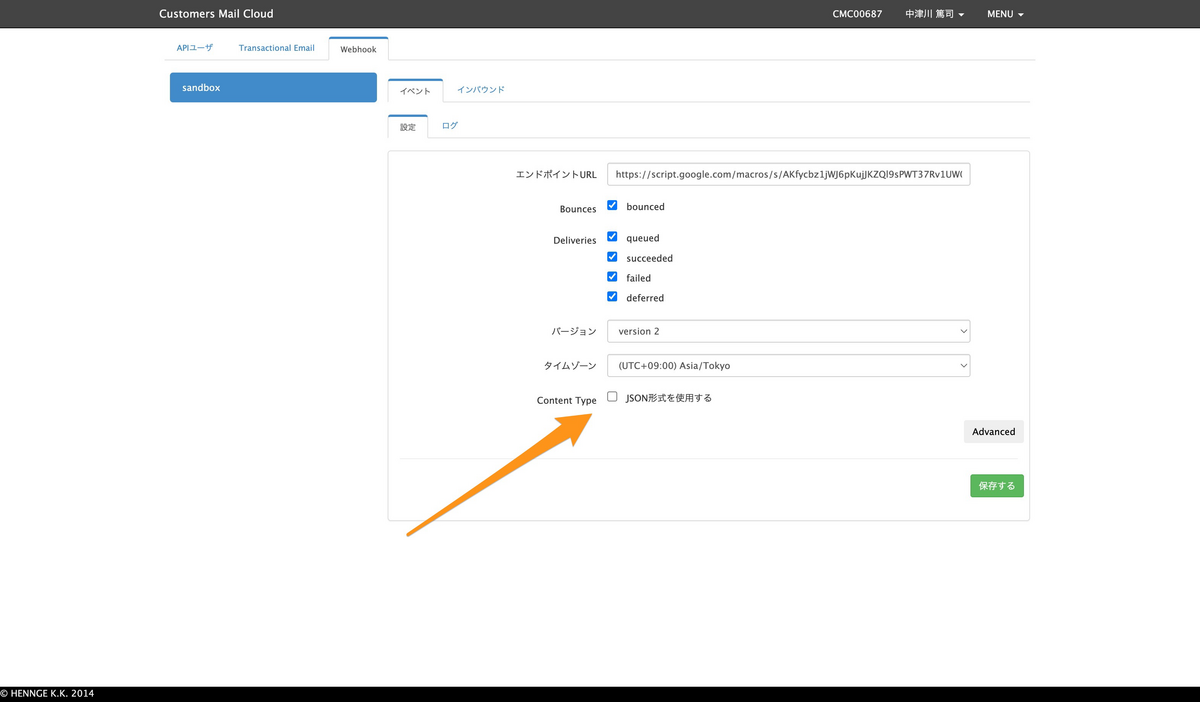Customers Mail CloudのWebhookは2種類あります。
- メール受信時
- メール送信時
メール送信時は、送信したメールに対してステータスが変わったタイミングで通知が送られるものです。
その際、 application/json を指定しない設定ができます。この時のデータがどうなっているのか紹介します。
<!—more—>
Google Cloud Functionsの準備
今回はローカルで開発する流れを紹介します。まず、適当なフォルダを作成します。今回はcmcとします。
mkdir cmc cd cmc
次に hello_http.go というファイルを作成し、以下のように記述します。
package helloworld import ( "encoding/json" "fmt" "html" "net/http" "github.com/GoogleCloudPlatform/functions-framework-go/functions" ) func init() { functions.HTTP("HelloHTTP", HelloHTTP) } func HelloHTTP(w http.ResponseWriter, r *http.Request) { // ここに処理を記述 }
次に依存関係を追跡します。
go mod init example.com/hello go mod tidy
ローカルで実行できるようにする準備
cmc フォルダ内に cmd フォルダを作成します。
mkdir cmd
cmd/main.go ファイルを作成し、内容を以下のようにします。
package main import ( "log" "os" // Blank-import the function package so the init() runs _ "example.com/hello" "github.com/GoogleCloudPlatform/functions-framework-go/funcframework" ) func main() { // Use PORT environment variable, or default to 8080. port := "8080" if envPort := os.Getenv("PORT"); envPort != "" { port = envPort } if err := funcframework.Start(port); err != nil { log.Fatalf("funcframework.Start: %v\n", err) } }
残りの依存関係を解決します。
go mod tidy
後は以下のコマンドで http://localhost:8080 でサーバーが立ち上がります。
export FUNCTION_TARGET=HelloHTTP go run cmd/main.go
受け取るWebhookの設定
管理画面にて、受け取るWebhookを設定できます。設定は以下が用意されています。
- Bounces
- bounced(エラーメールを受け取る)
- Deliveries
- queued(キューに入ったタイミング)
- succeeded(送信完了)
- failed(送信失敗)
- deferred(送信延期)
この中で application/json を指定できます。指定しなかった場合、データは application/x-www-form-urlencoded にて送信されます。本記事ではこの場合を想定しています。

送信されてくるデータについて
メール送信した直後
メール送信を行うと、そのデータがキューに入ります。そして、以下のようなWebhookが送られてきます(データは一部マスキングしています)。データは分かりやすいようにJSONにしていますが、実際には異なりますので注意してください。
{ "event_type": "deliveries", "server_composition": "pro", "event": '{"deliveries":[{"reason":"","sourceIp":"100.100.100.1","returnPath":"info@return.pro.smtps.jp","created":"2023-01-25 14:03:06","subject":"メールマガジンのテスト","apiData":"","messageId":"<031a32d4-06cd-b1ae-9526-011c0b9f1296@example.com>","from":"info@example.com","to":"user@example.jp","senderIp":"","status":"queued"}]}' }
メール送信完了時
Customers Mail Cloudからメール送信処理が行われると、ステータスが succeeded になったWebhookが送られてきます。
{ "event_type": "deliveries", "server_composition": "pro", "event": '{"deliveries":[{"reason":"","sourceIp":"","returnPath":"info@return.pro.smtps.jp","created":"2023-01-25 14:03:09","subject":"メールマガジンのテスト","apiData":"","messageId":"<031a32d4-06cd-b1ae-9526-011c0b9f1296@example.com>","from":"info@example.com","to":"user@example.jp","senderIp":"100.100.100.3","status":"succeeded"}]}' }
メール送信失敗時(メールアドレス形式に問題がある場合)
メールアドレスの形式に問題があるなど、送信処理が失敗した場合には以下のようなWebhookが送られてきます。
{ "event_type": "bounces", "server_composition": "pro", "event": '{"bounces":[{"reason":"host unknown","returnPath":"info@return.pro.smtps.jp","created":"2023-01-25 14:05:15","subject":"メールマガジンのテスト","apiData":"","messageId":"<8f902ee7-ae65-8711-48a8-2f708cb14205@example.com>","from":"info@example.com","to":"user@example","status":"1"}]}' }
メール送信失敗時(送信先サーバーからエラーが返ってくる場合)
ユーザーが存在しない、メールボックスがいっぱいなど送信先サーバーからエラーが返ってきた場合には、以下のようなJSONが返ってきます。
{ "event_type": "deliveries", "server_composition": "pro", "event": '{"deliveries":[{"reason":"550 5.1.1 The email account that you tried to reach does not exist. Please try 5.1.1 double-checking the recipient's email address for typos or 5.1.1 unnecessary spaces. Learn more at 5.1.1 <https://support.google.com/mail/?p=NoSuchUser> b197-20020a621bce000000b0058b80756b07si311029pfb.3 - gsmtp (in reply to RCPT TO)","sourceIp":"","returnPath":"info@return.pro.smtps.jp","created":"2023-01-25 14:06:06","subject":"メールマガジンのテスト","apiData":"","messageId":"<9e7e564c-ac83-8cd8-2cb4-b9ff2a9f168d@example.com>","from":"info@example.com","to":"no-user@example.jp","senderIp":"100.100.100.3","status":"failed"}]}' }
エラーとしてのWebhookも送られてきます。上記のものと event_type が異なるので注意してください。
{ "event_type": "bounces", "server_composition": "pro", "event": '{"bounces":[{"reason":"550 5.1.1 The email account that you tried to reach does not exist. Please try 5.1.1 double-checking the recipient's email address for typos or 5.1.1 unnecessary spaces. Learn more at 5.1.1 <https://support.google.com/mail/?p=NoSuchUser> b197-20020a621bce000000b0058b80756b07si311029pfb.3 - gsmtp (in reply to RCPT TO)","returnPath":"info@return.pro.smtps.jp","created":"2023-01-25 14:06:07","subject":"メールマガジンのテスト","apiData":"","messageId":"<9e7e564c-ac83-8cd8-2cb4-b9ff2a9f168d@example.com>","from":"info@example.com","to":"no-user@example.jp","status":"2"}]}' }
Go言語のコード
処理は hello_http.go の HelloHTTP 関数内に記述します。
func HelloHTTP(w http.ResponseWriter, r *http.Request) { // ここに処理を記述 }
送られてくるデータは r.ParseForm() で受け取れます。この後は r.Form[キー] でアクセスできますが、 event キー以下は文字列になっています。そのため、追加で json.Unmarshal を行って、構造体へ適用します。
var MailStatus struct { Reason string `json:"reason"` SourceIP string `json:"sourceIp"` ReturnPath string `json:"returnPath"` Created string `json:"created"` Subject string `json:"subject"` APIData string `json:"apiData"` MessageID string `json:"messageId"` From string `json:"from"` To string `json:"to"` SenderIP string `json:"senderIp"` Status string `json:"status"` } var Webhook struct { Deliveries []MailStatus `json:"deliveries"` Bounces []MailStatus `json:"bounces"` } r.ParseForm() if err := json.Unmarshal([]byte(r.Form["event"][0]), &Webhook); err != nil { fmt.Println(err) return }
これで Webhook に対してアクセスできます。
fmt.Fprintln(w, r.Form["event_type"]) // deliveries fmt.Fprintln(w, Webhook.Deliveries[0].Subject) // メールマガジンのテスト
まとめ
Webhookを使うことで、メール送信ステータスの変化に応じて通知を受け取れるようになります。メールと連携したシステムを開発する際に役立つでしょう。
Go言語の場合は application/json を指定した方が全体として、受け取りやすい印象です。ぜひお試しください。なお、このWebhookはSMTP経由の場合、利用できます。
